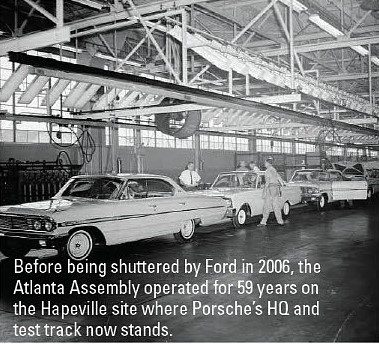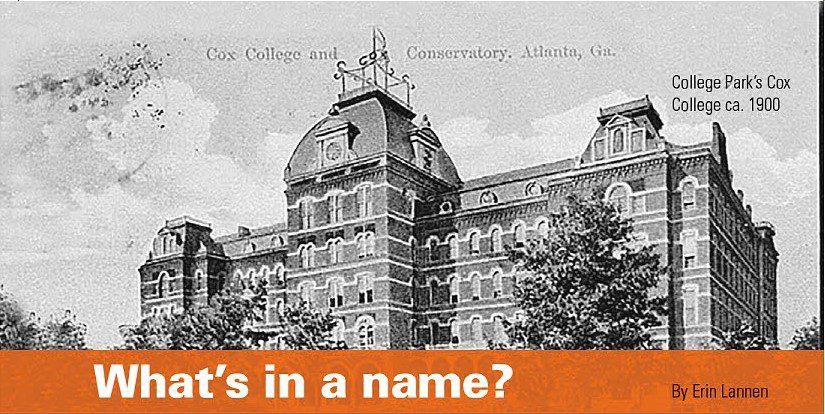The beloved cities that comprise the ATL Airport District, located south of downtown Atlanta and nestled around the world’s busiest airport, each have a rich history with humble begin-nings. Let’s explore how our favorite Southside municipalities came to be.
College Park
Meet College Park, home to Hartsfield-Jackson Atlanta International Airport and the Georgia International Convention Center. Well-accus-tomed to visitors, it’s aptly known as “Georgia’s Global City.”
In 1890, when College Park was little more than a train depot, it was founded under the name Atlantic City. Later, in 1891, it was incorporated as the city of Manchester. It was five more years before it earned its current name. College Park. a nod to the Georgia Military Academy (now known as Woodward Academy, the largest independent school in the United States) and Cox College. Cox, a private women’s college founded in LaGrange, had just moved to Manchester in 1895 with a campus on Main Street. where College Park’s City Hall now stands.
Today. College Park boasts the fourth-largest historic district in Georgia, with over 800 recognized historic buildings and homes. The Main Street Business District-directly across from the College Park MARTA station-is vibrant and thriving. And Chick-fil-A’s Headquar-ters proudly calls College Park home.
East Point
Considering East Point is actually located south-west of Atlanta, the name can be confusing for olks not familiar with its rich railroad history. In 1870, with the help of 16 local families, the city was founded as a railroad terminus;
“East Point” was the easternmost point on the Atlanta & West Point Railroad. A catalyst for industrial development, the rail line enabled two gristmills, a government distillery, various factories, a steam-cotton gin, and a sawmill. By 1880, East Point had its own weekly newspa-per, The Plow Boy, aptly named for the expand-ing grain and cotton businesses around town. By 1887, the city was officially chartered.
Steeped in industry for over a century, this eclectic city continues to be a place for enter-prise, supporting businesses big and small. The charming East Point community is also home to quiet neighborhoods. a growing arts scene. the headwaters of the Flint River, and the Dick Lane Velodrome (the only steeply banked bicycle track in the state).
The East Point Historical Society operates in an historic home that has been moved from the corner of East Point Street and Washington (where the post office is now) to Norman Berry Drive, on the site of the old community swimming pool. Here, East Pointers like longtime Historical Society volunteer Charles Chambers preserve East Point’s days gone by. Ask him about his alma mater, William A. Rus-sell High School-since replaced by Tri-Cities High School-or the streetcar that reigned over Willingham Drive back in the 1940’s, before cars were allowed to use it. These knowledge-able volunteers are eager to lead you on a carefully curated trip down memory lane.
Hapeville
One man is largely responsible for the city of Hapeville’s inception. In 1861, Samuel Hape left Union-loyal Maryland to serve in the Confeder-ate Army as Second Lieutenant in the Second Georgia Regiment. After being wounded and discharged, he was sent to England to request a British loan on behalf of the Confederacy. Upon his return to Atlanta, Hape founded the still-active Atlanta Dental Supply, and with some other investors, purchased 500 acres of land on the Macon and Western Central Georgia Railroad. This would become the city of Hapeville, officially chartered in 1891, and Hape would become its first elected mayor.
Visitors can explore Hapeville’s dynamic his-tory at the Hapeville Depot Museum, located inside the old train depot. Filled with artifacts highlighting the city’s ties to aviation and the railroad, along with treasures donated to the depot by past and present Hapevillians, it’s affectionately referred to as “Hapeville’s Attic· by depot volunteers.
The smallest of the cities at only 2.4 square miles, Hapeville may be mini, but it packs a lively punch. It’s home to art galleries, striking murals in every direction, a thriving city center. Delta Headquarters, Porsche Cars North America Headquarters (technically in the city of Atlanta but soon to expand next door to Hapeville). Arches Brewing (the town’s first brewery), and the original Chick-fil-A Dwarf House.
Union City
While Hapeville can give most of its establish-ment credit to one man, it took two to found Union City: Charles Simon Barrett and Drewry Arthur Carmichael. Barrett became the president of the Georgia chapter of the National Farmers Union in 1905, and its national president in 1906. He sought to relocate the union’s headquarters and settled on Union City-in part thanks to the influence of Carmichael, an established farmer in the area and inventor of the “Carmichael lmplements”-the combined seed and fertilizer distributor, single fertilizer and planter, the combined turning and subsoil plow, and the gin compress, all of which were manufactured in Union City.
In 1908, a charter was established for the new town of Union City, officially named after the National Farmers Union. That same year, Carmi-chael gave away some of his land for the new town. He helped secure the Atlanta. Birmingham and Atlantic Railway to roll through Union City and worked to connect a track to the Atlanta and West Point Railroad. Carmichael was Union City’s first elected mayor and remained active in the National Farmers Union. Barrett remained union president until 1926.
Today, Union City is a quiet bedroom community with a growing business district and one of the largest soundstages in the Southeast. It’s also home to one of the most celebrated (and reput-edly haunted) eateries in the area, Green Manor Restaurant.

By Erin Lannen

